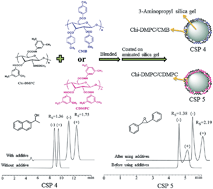Enantioseparation characteristics of chiral stationary phases based on the derivatives of cellulose and chitin†
Abstract
The chiral stationary phases (CSPs) of cellulose derivatives show highly chiral resolving capability towards racemates. Some CSPs have been commercialized and applied quite popularly. However, cellulose derivatives can dissolve or swell considerably in some organic solvents, such as chloroform and ethyl acetate; moreover, the CSPs prepared by a coating method can only be utilized in a limited range of eluents. To compensate for this defect, chitin bis(3,5-dimethylphenylcarbamate) (Chi-DMPC) with high solvent tolerance was blended with cellulose tris(4-methylbenzoate) (CMB) and cellulose tris(3,5-dimethylphenylcarbamate) (CDMPC) at a ratio of 1 : 1 (mol mol−1) of glucose unit to obtain two biselectors, and then coated on 3-aminopropyl silica gel, to afford two biselector CSPs, expecting to enhance the stability of CSPs by blending method. To compare the chromatographic properties, the corresponding single selector CSPs were also prepared. The ability of enantioseparation and solvent tolerance of these biselector CSPs was investigated systematically. Owing to the low solubility of Chi-DMPC in organic solvents and the interaction between Chi-DMPC and the cellulose derivatives, the analysis with CHCl3- and AcOEt-containing mobile phases could be carried out on these biselector CSPs. In addition, the resolution of most analytes was enhanced under the same conditions after running the biselector CSPs with the CHCl3- and AcOEt-containing mobile phases.


 Please wait while we load your content...
Please wait while we load your content...